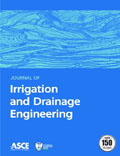Flow Measurement with Trapezoidal Free Overfall
Publication: Journal of Irrigation and Drainage Engineering
Volume 115, Issue 1
Abstract
The trapezoidal free overfall is analyzed by the one‐dimensional momentum equation, including an assumed pressure distribution at the brink. The pressure distribution is based on previous measurements in rectangular and triangular open channels. The predicted relationship between brink depth and discharge is compared with experimental data from a laboratory flume, and excellent agreement is evident. A calibration chart, applicable to any mild slope trapezoidal channel, is developed theoretically and checked against the data from the present study and data from previous studies. Again excellent agreement is noted. Comparison with previous predictive techniques, in which the pressure distribution at the brink was assumed to be uniformly atmospheric, illustrates the importance of including this pressure distribution in the analysis.
Get full access to this article
View all available purchase options and get full access to this article.
References
1.
Bauer, S. W., and Graf, W. J. (1971). “Free overfall as flow measuring device.” J. Irrig. and Drain., ASCE, 97(IR1), 73–73.
2.
Christodoulou, G. C., Noutsopoulos, G. C., and Andreou, S. A. (1984). “Factors affecting brink depth in rectangular overfalls.” Proc. First Int. Conf. on Channels and Channel Control Structures, Southampton, England, Apr., Springer‐Verlag, Berlin, 1–3–1–17.
3.
Delleur, J. W., Dodge, J. C. I., and Gent, K. N. (1956). “Influence of slope and roughness on the free overfall.” J. Hydr. Engrg., ASCE, 82(HY4), 1038–30–1038‐35.
4.
Diskin, M. H. (1961). “End depth at a drop in trapezoidal channels.” J. Hydr. Engrg., ASCE, 87(HY4), 11–32.
5.
Fathy, A., and Shaarawi, A. M. (1954). “Hydraulics of the free overfall.” Proc. ASCE 80, Separate No. 564.
6.
Fong, S. S. (1982). “Experimental and theoretical study of the free overfall in a trapezoidal channel,” thesis submitted to Monash University, Clayton, Australia, in partial fulfillment of the requirements for the degree of Master of Engineering Science.
7.
Hamid, H. I. (1962). Discussion of “End depth at a drop in trapezoidal channels,” by M. H. Diskin. J. Hydr. Engrg., ASCE, 88(HY1), 133–136.
8.
Kraijenhoff, D. A., and Dommerholt, A. (1977). “Brink depth method in rectangular channel.” J. Irrig. and Drain., ASCE, 103(IR2), 171–177.
9.
Neogy, B. N. (1972). “Brink depth for trapezoidal broad‐:crested weir.” J. Hydr. Engrg., ASCE, 98(HY12), 2171–2189.
10.
Rajaratnam, N. (1962). Discussion of “End depth at a drop in trapezoidal channels,” by M. H. Diskin. J. Hydr. Engrg., ASCE, 88(HY1), 119–130.
11.
Rajaratnam, N., and Muralidhar, D. (1964a). “End depth for circular channels.” J. Hydr. Engrg., ASCE, 90(HY2), 99–119.
12.
Rajaratnam, N., and Muralidhar, D. (1964b). “End depth for exponential channels.” J. Irrig. and Drain., ASCE, 90(IR1), 17–39.
13.
Replogle, J. A. (1962). Discussion of “End depth at a drop in trapezoidal channels,” by M. H. Hydr. Engrg., ASCE, 88(HY2), 161–165.
14.
Rouse, H. (1936). “Discharge characteristics of the free overfall.” Civ. Engrg., ASCE, 6(4), 257–260.
15.
Smith, C. D. (1962). “Brink depth for circular channels.” J. Hydr. Engrg., ASCE, 88(HY6), 125–134.
Information & Authors
Information
Published In
Copyright
Copyright © 1989 ASCE.
History
Published online: Feb 1, 1989
Published in print: Feb 1989
Authors
Metrics & Citations
Metrics
Citations
Download citation
If you have the appropriate software installed, you can download article citation data to the citation manager of your choice. Simply select your manager software from the list below and click Download.
